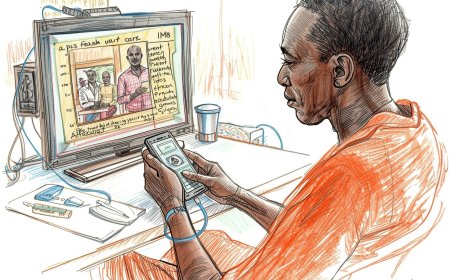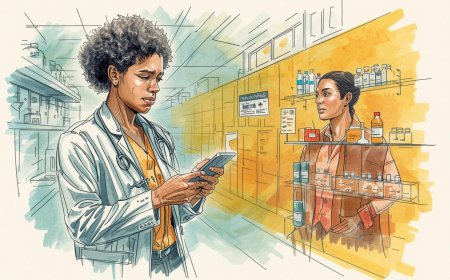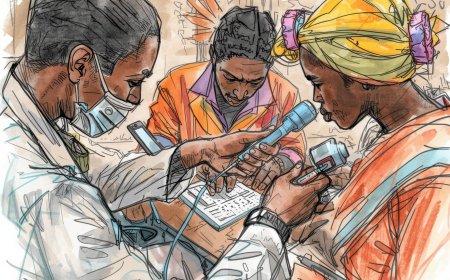Implementing Clinical Decision Support AI in District Hospitals: A Practical Guide
A pragmatic, Africa-focused playbook for implementing Clinical Decision Support (CDS) and AI-assisted decision tools at district hospitals. Covers evidence, ethics, data governance, infrastructure needs, procurement partners, training, evaluation metrics, and rollout checklists — with rib-cracking anecdotes and realistic African case studies. APA citations and live links included.

Short brief: This is for district medical officers, hospital managers, health-tech leads and NGO program officers who want to deploy clinical decision support (CDS) — including AI-powered tools — in district hospitals across Africa without breaking the budget, the staff morale, or the patients’ trust. Expect clear steps, a realistic 6–12 month roadmap, legal checkpoints, and two case vignettes that will make your senior clinician snort-tea-and-approve-the-pilot.
Opening anecdote (rib-cracking, but painfully true)
“Meet Dr. Kofi — a clinician who once got an alert from a CDS saying ‘consider aspirin’ for a febrile child. He sighed, checked the app, then looked at the child. The CDS had suggested adult-dose aspirin because someone forgot to enter the child’s weight. The child is fine, the app was updated, and Dr. Kofi now introduces every junior clinician to the ‘type your numbers, don’t assume the algorithm will be psychic’ ritual.”
Lesson: CDS helps, but human checks, good data entry and sensible alerts are the lifeblood of safe deployment.
Why CDS/AI matters for district hospitals in Africa (short & sharp)
District hospitals manage high volumes of emergencies, maternal/newborn care, referral triage, antimicrobial stewardship, and basic surgery. Properly designed CDS tools can:
-
Improve adherence to evidence-based protocols at point of care. Digital Healthcare Research
-
Reduce diagnostic and treatment delays where specialists aren’t available. World Health Organization
-
Support triage, early warning, and task-shifting for non-physician clinicians. BioMed Central
But — and this is big — CDS must be clinically validated in the local context, ethically governed, and integrated into workflows. WHO and other authorities insist AI for health follow explicit ethical and governance principles. World Health Organization+1
What “CDS” and “AI-powered CDS” really mean (definitions)
-
Clinical Decision Support (CDS): digital tools that provide clinicians with timely, patient-specific information (alerts, order sets, diagnostic suggestions, dosing calculators) at the point of care. Digital Healthcare Research
-
AI-powered CDS: CDS that uses machine learning or other AI methods (e.g., prediction models, image interpretation) to generate recommendations. These may require additional validation and governance steps compared with rule-based CDS. Regulatory bodies (e.g., FDA) publish guidance on which CDS functions are considered regulated medical devices. U.S. Food and Drug Administration+1
Core success principles — the short checklist you’ll repeat at meetings
-
Clinician-centred design — start with the decision point, not the shiny algorithm. PMC
-
Local validation — test in your climate, caseload and patient population. BioMed Central
-
Data quality & minimum dataset — if clinicians can’t quickly enter accurate inputs, the CDS will hallucinate. (Yes — clinically actionable hallucinations exist.) PMC
-
Explainability & safe defaults — make recommendations transparent and conservative. World Health Organization
-
Governance & data protection — comply with national laws (e.g., Kenya, Nigeria, South Africa). Kenya Law+2NITDA+2
-
Workflow integration & minimal clicks — reduce, don’t add, cognitive load. Digital Healthcare Research
Step-by-step implementation roadmap (6–12 months for a meaningful pilot)
Phase 0 — Problem selection & stakeholder convening (Week 0–4)
-
Choose 1–2 high-impact decisions (e.g., obstetric triage, sepsis early-warning, antibiotic prescribing). Narrow focus prevents scope creep. Involve clinicians, nurses, IT and hospital admin.
-
Agree success metrics (e.g., time-to-antibiotic for sepsis, adherence to PPH protocol, reduction in inappropriate antibiotic prescriptions). JMIR+1
Phase 1 — Evidence review & design (Month 1–2)
-
Map existing clinical guidelines to digital rules (WHO SMART Guidelines are a recommended approach for translating narrative guidance into digital algorithms). World Health Organization+1
-
Choose technology approach: rule-based CDS (faster, simpler) vs AI models (more powerful, more governance). For first pilots in district hospitals I recommend rule-based + a simple prediction model if you have good local data. Digital Healthcare Research+1
Phase 2 — Build & localize (Month 2–4)
-
Build minimal viable CDS (MVP) integrated to existing workflows (paper forms, EMR, or tablet). Ensure minimal data fields required.
-
Embed clear, non-intrusive alerts with “accept / override + reason” options. Avoid alert storms. PMC
Phase 3 — Validation (Month 4–6)
-
Technical validation: test algorithm outputs on historical records (retrospective validation).
-
Clinical validation: small prospective pilot in 1–2 wards (~50–200 patients depending on endpoints). Use local endpoints and supervise closely. Published pilots in Rwanda and other African settings have used pragmatic run-in phases successfully. BioMed Central+1
Phase 4 — Training & go-live (Month 6–9)
-
Train clinicians using case-based sessions, bedside shadowing and a 1-page SOP pinned in the ward. Assign local “CDS champions.”
-
Go live for defined shifts; monitor real-time safety logs and clinician feedback. PMC
Phase 5 — Evaluate & iterate (Month 9–12+)
-
Measure your pre-defined metrics, usability, and any unintended consequences (e.g., alert overrides, delays). Iterate the rules and expand scope if successful. Publish or share lessons with Ministry and partners. PMC
Data, privacy & legal checkpoints (non-negotiable)
District hospitals must treat CDS data like clinical data:
-
Minimize data: collect only what’s needed for the decision.
-
Local law compliance: be aware of national privacy laws — Kenya’s Data Protection Act (2019), Nigeria’s NDPR (2019), South Africa’s POPIA (2013). Register processing activities and appoint responsible officers where required. Kenya Law+2NITDA+2
-
Security basics: encryption in transit (TLS), role-based access, audit logs, and documented breach procedures.
-
Consent & transparency: clinicians and patients should know when AI is used and what it can (and cannot) do — WHO recommends explicit governance measures for AI in health. World Health Organization
Algorithm safety, monitoring & explainability
-
Prefer conservative thresholds (prioritize sensitivity OR specificity depending on the clinical goal).
-
Log every recommendation, the inputs used, and clinician overrides. Use these logs as the primary dataset for re-calibration.
-
Maintain a “human-in-loop” default: CDS recommends; clinicians decide. If using ML models, provide simple explanations (e.g., top 3 features influencing the score) for auditability. WHO AI guidance emphasizes explainability and continuous monitoring. World Health Organization
Infrastructure realities — power, connectivity, devices
District hospitals vary widely:
-
Power: expect brownouts; provide offline-capable apps and UPS for critical workstations.
-
Connectivity: design for offline-first workflows and batched syncs; SMS fallbacks for essential alerts. WHO SMART guideline implementations stress offline resilience. World Health Organization+1
-
Hardware: tablets or low-cost workstations plus one training device per ward. Avoid relying on BYOD unless secure MDM is in place.
Training & change management (the human half)
-
Run short, practical workshops with real cases (not slide-decks). Use simulation on the ward.
-
Appoint local champions (nurse + clinician) to triage technical issues within the shift.
-
Use “rapid feedback” loops (daily for week 1, weekly for month 1) to adapt alerts and UX. Studies of CDSS adoption show clinician engagement and perceived usefulness are top predictors of sustained use. PMC
Evaluation metrics — what to measure (KPIs)
Pick 6–8 metrics across effectiveness, safety, adoption and cost:
-
Clinical: adherence to guideline, time-to-treatment, diagnostic accuracy. BioMed Central
-
Safety: number of adverse events, proportion of alerts overridden, false positive rate.
-
Adoption: % clinicians using CDS per shift, average sessions/day.
-
System: uptime, sync latency, number of data-entry errors.
-
Cost: cost per patient triaged, reduction in unnecessary referrals or antibiotic days. Use pre/post designs or stepped-wedge trials if possible. PMC
Procurement, funding & partners (who to call and when)
-
WHO digital health / SMART Guidelines — for mapping evidence to digital algorithms and national alignment. World Health Organization
-
Ministries of Health / District Health Offices — for local adoption, policy alignment and scale.
-
Donors & implementers — UNICEF, PATH, FIND, CDC, Global Fund support digital health pilots and procurement. Engage them early for alignment to national priorities. PMC+1
-
Academic partners — for validation studies and ongoing monitoring. Local medical schools are often eager collaborators.
Two African-flavoured case studies (real studies you can read)
1) Rwanda — digital application for obstetric emergencies (real pilot)
A decision-support application (SDA) for managing postpartum haemorrhage (PPH) and neonatal resuscitation was tested in two district hospitals in Rwanda; nurses and midwives used the tool for 6 months. The pilot showed improved adherence to BEmONC protocols and was feasible in district settings with appropriate training and supervision. This is a practical example of clinically-focused CDS in African district hospitals. BioMed Central
2) Antimicrobial prescribing CDSS in West & Central Africa (implementation study)
A 2024 study explored implementation factors for an antimicrobial CDSS across countries in West and Central Africa, identifying contextual barriers (infrastructure, trust, training) and facilitators (local champions, alignment with national stewardship goals). This highlights that antimicrobial stewardship CDS is promising but demands careful localisation. JMIR
(For cost-focused historical perspective, Ghana’s Kassena-Nankana district analysis of a CDSS implementation offers lessons on costs and scalability.) PMC
Common traps and how to avoid them (short punchy list)
-
Trap: Deploying an algorithm without local validation. Fix: Run small prospective pilots before scale. BioMed Central
-
Trap: Alert fatigue from noisy notifications. Fix: Use tiered alerts and conservative thresholds; monitor override rates. PMC
-
Trap: Ignoring data protection laws. Fix: Do a legal checklist and minimal data collection; appoint a data steward. Kenya Law+1
-
Trap: Leaving clinicians unsupported. Fix: Train, support, and keep human-in-loop decisions.
Quick ward-ready SOP (pin this to the nurses’ station)
-
For every CDS recommendation, collect the minimal inputs (per SOP) before accepting.
-
Document any overrides with reason (free-text or selectable list).
-
If system suggests high-risk intervention, call senior clinician (phone escalation).
-
Log and report any suspect CDS-related adverse event within 24 hours to hospital governance and the implementation team.
-
Monthly: review dashboard metrics (adoption, overrides, key clinical KPIs).
One-page pilot checklist (copy-paste into your procurement email)
-
Problem selected & metrics agreed? Y/N.
-
Clinician champions identified? Y/N.
-
Local validation dataset available? Y/N.
-
Offline-first app with UPS and sync plan? Y/N.
-
Data protection compliance (local law) assessed? Y/N. Kenya Law+2NITDA+2
-
Training plan, SOP, and escalation pathway ready? Y/N.
-
Real-time monitoring dashboard connected? Y/N.
Final practical notes (reality checks)
-
Start small, with one clear decision (e.g., triage/antibiotic use/PPH bundle).
-
Expect 6–12 months from concept to reliable pilot data.
-
Share results with Ministry and peer hospitals; successful pilots commonly scale through Ministry endorsement. WHO SMART Guidelines and WHO AI ethics documents can help your policy conversations. World Health Organization+1
References (APA — live links)
-
World Health Organization. (2021). Ethics and governance of artificial intelligence for health: WHO guidance. https://www.who.int/publications/i/item/9789240029200. World Health Organization
-
World Health Organization. (n.d.). SMART Guidelines — Standards-based, Machine-readable, Adaptive, and Reusable Templates for digital health guidance. https://www.who.int/teams/digital-health-and-innovation/smart-guidelines. World Health Organization
-
Agency for Healthcare Research and Quality. (n.d.). Clinical Decision Support (CDS) — digital health resources. https://digital.ahrq.gov/health-it-tools-and-resources/clinical-decision-support-cds. Digital Healthcare Research
-
U.S. Food and Drug Administration. (2022). Clinical Decision Support Software — Guidance for Industry and FDA Staff (Final Guidance, Sept 28, 2022). https://www.fda.gov/regulatory-information/search-fda-guidance-documents/clinical-decision-support-software. U.S. Food and Drug Administration
-
Nishimwe, A., et al. (2022). The effect of a decision-support mHealth application on management of postpartum haemorrhage and neonatal resuscitation: a pilot in two district hospitals in Rwanda. BMC Pregnancy and Childbirth. https://bmcpregnancychildbirth.biomedcentral.com/articles/10.1186/s12884-022-04393-9. BioMed Central
-
Peiffer-Smadja, N., et al. (2024). Implementation of a Clinical Decision Support System for antimicrobial prescribing in West and Central Africa: factors and lessons. Journal of Medical Internet Research. https://www.jmir.org/2024/1/e45122/. JMIR
-
Meunier, P. Y., et al. (2023). Barriers and Facilitators to the Use of Clinical Decision Support Systems by Primary Care Professionals: A systematic review. https://www.ncbi.nlm.nih.gov/pmc/articles/PMC9870646/. PMC
-
Dalaba, M. A., et al. (2014). Costs and lessons learned implementing a computer-assisted Clinical Decision Support System in primary care in Kassena-Nankana District, Northern Ghana. https://www.ncbi.nlm.nih.gov/pmc/articles/PMC4152286/. PMC
-
Matthys, B., et al. (2025). Development and implementation of a digital clinical decision support system in resource-limited settings. (Recent implementation/lessons). https://pmc.ncbi.nlm.nih.gov/articles/PMC12004631/. PMC
-
Republic of Kenya. (2019). Data Protection Act, No. 24 of 2019. https://kenyalaw.org/kl/fileadmin/pdfdownloads/Acts/2019/TheDataProtectionAct__No24of2019.pdf. Kenya Law
-
National Information Technology Development Agency (NITDA). (2019). Nigeria Data Protection Regulation (NDPR). https://nitda.gov.ng/wp-content/uploads/2020/11/NigeriaDataProtectionRegulation11.pdf. NITDA
-
Government of South Africa. (2013). Protection of Personal Information Act (POPIA). https://www.gov.za/sites/default/files/gcis_document/201409/3706726-11act4of2013protectionofpersonalinforcorrect.pdf. Government of South Africa
What's Your Reaction?
 Like
0
Like
0
 Dislike
0
Dislike
0
 Love
0
Love
0
 Funny
0
Funny
0
 Angry
0
Angry
0
 Sad
0
Sad
0
 Wow
0
Wow
0















































